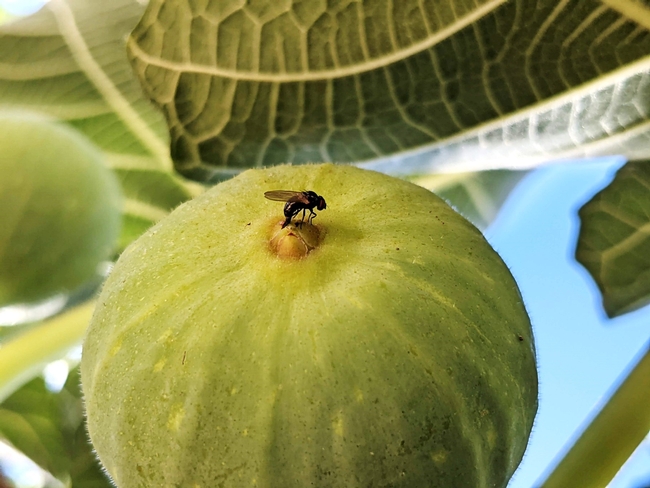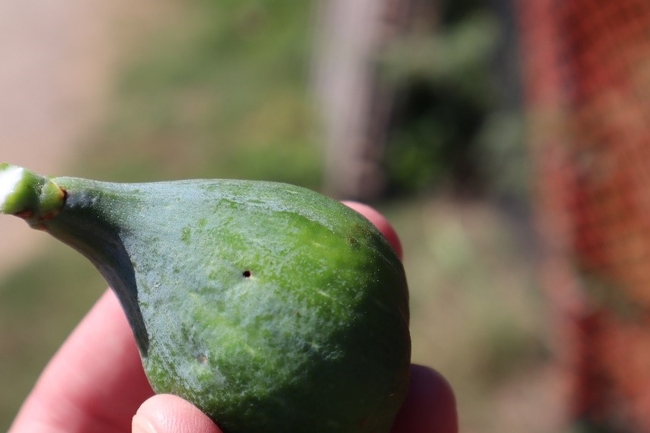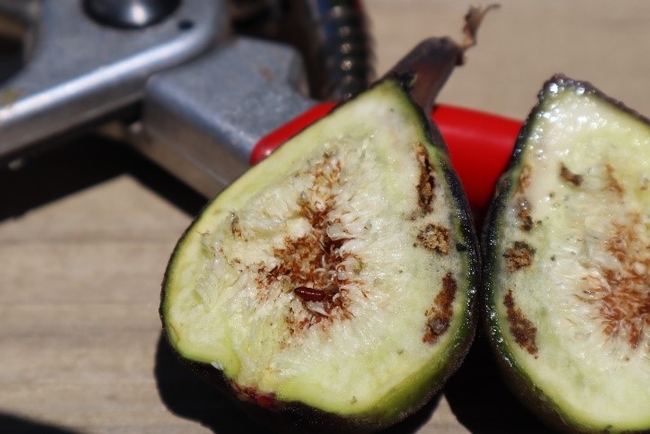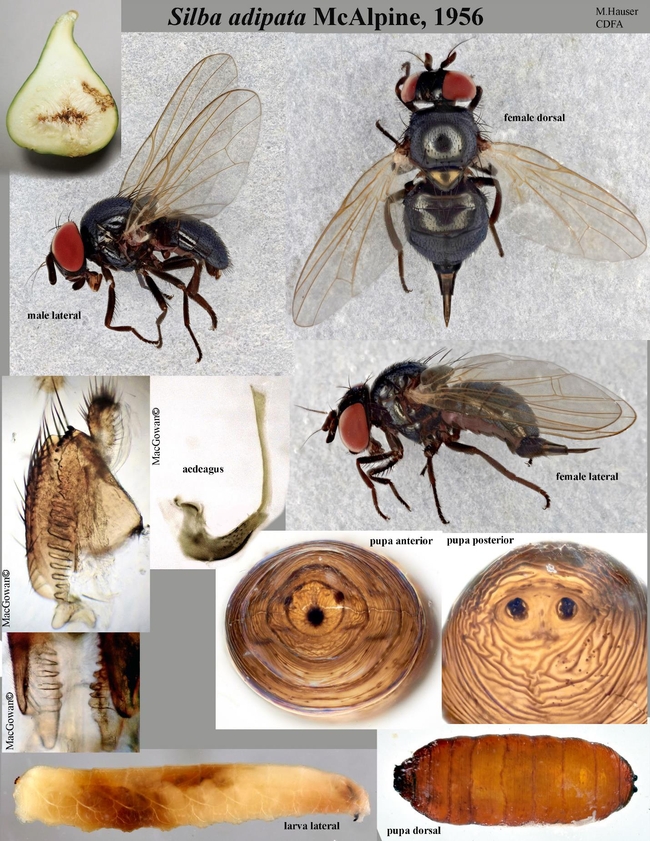
Posts Tagged: bff
Watch for Fig Fly
PEST ALERT – Black Fig Fly
(Diptera: Lonchaeidae: Silba adipata)
Invasive Fig Pest Recently Discovered in Southern California
Overview: Fig growers need to be aware of the black fig fly (BFF), an invasive insect that was recently discovered infesting figs in multiple counties in southern California. The BFF has been reported in the following counties: Los Angeles, Orange, Riverside, Santa Barbara, San Bernardino, San Diego and Ventura. Movement of figs from these counties is strongly discouraged to prevent any artificial spread of BFF to other areas of the state. University of California Cooperative Extension personnel are currently working with the California Department of Food and Agriculture to further delineate populations, as well as develop improved monitoring and management strategies.
Life Cycle: The BFF only attacks figs and prefers unripe and unfertilized fruits. The adult female deposits eggs into the fruit through the ostiole (Figure 1) 
and larvae subsequently feed internally on the fruit (Figure 2).
This feeding damages the fruit and causes it to prematurely drop from the tree. Upon completion of development, the BFF larvae make their way out of the fruit (Figure 3),
drop to the soil and pupate. In some cases, BFF pupae have been recovered inside of fruits as well (Figure 4).
Black fig flies overwinter as pupae in the soil. In the spring they emerge, mate and begin to attack figs. The BFF can have between 4 to 6 generations per year (more in warmer areas, fewer in cooler areas).
Monitoring: Fig fruits can be inspected for signs of BFF activity, such as larval feeding or exit holes. Focus on unripe fruits that have recently fallen from the tree. Populations of BFF adults can also be monitored using McPhail-type traps (Figure 5) baited with torula yeast lures, although the efficacy of this trap/lure combination is still under evaluation.
Management: Biological control appears to be limited and there are currently no chemical controls registered specifically for this pest on California figs. As such, orchard sanitation is critical, and growers should make sure to remove and destroy any BFF-infested fruits. Larvae in infested fruit are protected from pesticide sprays and there are no effective soil drenches for pupal control. Insecticidal baits (e.g. GF-120 NF Naturalyte®) may be useful for control of adult BFF but note that label rates have not been directly tested for efficacy against this pest. Consult with a licensed pest control adviser and your County Agricultural Commissioner before applying any chemical controls.
Do Not Move Figs: California figs are primarily grown in the Central Valley between Merced and Fresno, with many smaller orchards spread along the coast and in southern California. Movement of figs from the infested counties is strongly discouraged to prevent any artificial spread of BFF to other areas of California.
Reporting the Pest: If you find infested fruit or suspect that BFF may be attacking fruits in your orchard, please contact your local UCCE Farm Advisor and/or County Agricultural Commissioner.
Contact Information: If you have any additional questions, please contact Houston Wilson (Houston.wilson@ucr.edu).
Authors: Houston Wilson (Dept. Entomology, UC Riverside), Kadie Britt (Dept. Entomology, UC Riverside), Phoebe Gordon (UC Cooperative Extension), Ben Faber (UC Cooperative Extension), and Sonia Rios (UC Cooperative Extension).

bff female
New Pest on Figs
The following is a pest rating proposal by Kyle Beucke (CDFA)” with some photographs by Martin Hauser (CDFA) and Iain MacGowan:
On June 10, 2021, a resident in Pasadena (Los Angeles County) submitted a fig with pupae to county agricultural personnel. The pupae were confirmed as Silba adipata with molecular techniques. On June 21, 2021, a resident in Goleta (Santa Barbara County) submitted figs with larvae to county agricultural personnel. These were also confirmed as S. adipata with molecular techniques. On June 24, 2021, a larva from a fig at the Goleta residence was collected by state (CDFA) personnel and this was confirmed as S. adipata with molecular techniques. On June 29, 2021, an adult male was confirmed as S. adipata via morphology of the genitalia. Further finds of S. adipata were made in Orange and Ventura counties. Silba adipata was not previously known to be established in the New World and it has not been rated. Therefore, a pest rating proposal is needed.
History & Status:
Background: Adult Silba adipata are black shining flies 3.5-4.5 mm in length. Adults feed on exudates of figs and fig tree sap and possibly in flowers of other plants. Edible fig (Ficus carica) is the only known larval host, and both figs and caprifigs are attacked. Female flies oviposit groups of eggs under the scales of the ostiole of the fruit, and unripe fruits are reported to be preferred for oviposition. Oviposition is reported to primarily occur on figs that are in a shaded position. Adult activity is reported to be greatest early in the morning and late in the afternoon, when temperatures are lower. Larvae feed inside the fruit, and this often results in premature fruit drop. Larvae can complete development in dropped fruit, and they emerge from emergence holes approximately 1 mm in diameter to pupate in the soil (Abbes et al., 2021; Katsoyannos, 1983; M. Hauser, pers. comm.). There are reportedly 4-6 generations per year (Katsoyannos and Guerin, 1984). Adults are active in Turkey from May to November (Tutmus, 2013).
Infestations by S. adipata caused fruit drop in Slovenia, but impact varied by location and fig variety (Rote et al., 2017). In Tunisia, it caused “massive” fruit dropand infestation rates (% of fruits infested) exceeded 80% in some cases. All varieties of figs there were reported to be susceptible (Abbes et al., 2021).
Hexanol and ammonium sulfate (use together gives three-fold increase over either alone) are attractive when used in McPhail traps (Katsoyannos and Guerin, 1984). Tutmus(2013) reported attraction of these lures to be increased greatly by the addition of fig “milk” (presumably sap).Regarding control, Abbes et al. (2021) suggested bait sprays, mass trapping, netting the fruits, and burying dropped fruit to limit development of larvae as potential control techniques. The pesticide DelegateTM250 WG is labeled for control of S. adipata on figs in South Africa (Corteva).
Worldwide Distribution: Silba adipata is reported to be native to the Mediterranean region and the Middle East. Its distribution includes: Africa: Egypt, South Africa (introduced), Tunisia; Asia: Israel, Syria, Turkey; Europe: Italy, Malta, Slovenia (introduced); North America: United States (California) (Abbes et al., 2021; D'Antonio and Fimiani, 1988; Giliomee, 2011; MacGowan and Freidberg, 2008; Mifsud et al., 2012; Rot et al., 2017; Tutmus, 2013). It was found in Morelos, Mexico in March 2020, but the status of this eradication is not known (United States Department of Agriculture).
Black Fly Damage
Black Fly Life Stages
References:
Abbes, K., Hafsi, A., Harbi, A., Mars, M., and Chermiti, B. 2021. The black fig fly Silba adipata (Diptera: Lonchaeidae) as an emerging pest in Tunisia: preliminary data on geographic distribution, bioecology and damage. Phytoparasitica. https://doi.org/10.1007/s12600-020-00871-y
Corteva. Accessed July 2, 2021: https://www.corteva.co.za/content/dam/dpagco/corteva/za/za/en/products/files/DELEGATE_ 250_WG_2020-02-05.pdf
D'Antonio, C. and Fimiani, P. 1988. Approccio ad un inventario entomofaunistico Dell'Isola di Vivara (NA). Noto preliminare. (1° contributo). Annuario del Museo Zoologico della Università di Napoli 26:155-170.
Giliomee, J. H. 2011. Recent establishment of many alien insects in South Africa –a cause for concern. African Entomology 19:151-155.
Katsoyannos, B. I. 1983. Field observations on the biology and behavior of the black fig fly Silba adipata McAlpine (Diptera, Lonchaeidae), and trapping experiments. Zeitschrift für Angewandte Entomologie 95:471-476
Katsoyannos, B. I. and Guerin, P. M. 1984. Hexanol: a potent attractant for the black fly, Silba adipata. Entomologia Experimentalis et Applicata 35:71-74.
MacGowan, I. and Freidberg, A. 2008. The Lonchaeidae (Diptera) of Israel, with descriptions of three new species. Israel Journal of Entomology 38:61-92.
Mifsud, D., Falzon, A., Malumphy, C., de Lillo, E., Vovlas, N., and Porcelli, F. 2012. On some arthropods associated with Ficus species (Moraceae) in the Maltese Islands. Bulletin of the Entomological Society of Malta 5:5-34.
Rot, M., Žežlina, I., Jancar, M., and Seljak, G. 2017. Crna figova muha (Silba adipata McAlpine, 1956 [Diptera, Lonchaeidae]) je zastopana tudi v Sloveniji. Zbornik predavanj in referatov 13:47-52.
Tutmus, E. 2013. Determination of distribution, population fluctuations and damage density of Silba adipata McAlpine (=Lonchaea aristella Becker) (Diptera: Lonchaeidae_ in fig orchards in Aydin. Master'sthesis, Adnan Menderes University, Aydin, Turkey. Accessed June 30, 2021: http://adudspace.adu.edu.tr:8080/xmlui/handle/11607/643
United States Department of Agriculture. APHIS Amends Import Requirements for Fresh Fig (Ficus carica) Fruit from Mexico. Accessed June 29, 2021: https://www.aphis.usda.gov/import_export/plants/plant_imports/federal_order/downloads/2 020/DA-2020-19.pdf
READ the CDFA Alert: https://blogs.cdfa.ca.gov/Section3162/wp-content/uploads/2021/07/Silba-adipata.pdf






